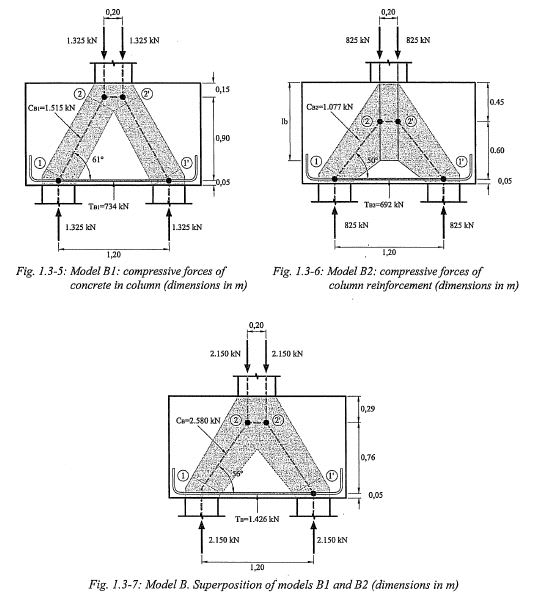Drapes
Structural
- Oct 27, 2012
- 97
In developing a strut and tie model, is it necessary to first split the load b/w the concrete and reinforcement and merge 2x models into 1x model?
I came across a worked example of a strut and tie model b/w a column and pile cap (refer attached), where 2x models (representing the load carried by the concrete and load carried by the reinforcement) were superimposed to give a final model and strut angle. The centreline of the nodes for the 'reinforcement' model was based on half the compressive development length of the bars, leading to a sharper strut angle that the 'concrete' model.
I suspect this superposition would only apply if the reinforcement is required to satisfy bearing. But if you have a column with say 2 to 2.5% reinforcement, and that reinforcement was only required to give the column adequate capacity under combined axial and moment over the height of the column, but under pure bearing the concrete alone was deemed sufficient at the column/pile cap interface, is there any need to split the model into two? In this case, would it be acceptable to simply create 1x model at the outset, apply the full load and go from there?
For example, simplistically if we assume a column with an axial capacity of 10000kN over the height of the column (with 8000kN contributed by the concrete and 2000kN contributed by the reinforcement), and the design load is 7000kN so there are no issues with bearing using the concrete capacity alone, can the load taken by the reo be ignored as far creating a strut and tie model is concerned?
I came across a worked example of a strut and tie model b/w a column and pile cap (refer attached), where 2x models (representing the load carried by the concrete and load carried by the reinforcement) were superimposed to give a final model and strut angle. The centreline of the nodes for the 'reinforcement' model was based on half the compressive development length of the bars, leading to a sharper strut angle that the 'concrete' model.
I suspect this superposition would only apply if the reinforcement is required to satisfy bearing. But if you have a column with say 2 to 2.5% reinforcement, and that reinforcement was only required to give the column adequate capacity under combined axial and moment over the height of the column, but under pure bearing the concrete alone was deemed sufficient at the column/pile cap interface, is there any need to split the model into two? In this case, would it be acceptable to simply create 1x model at the outset, apply the full load and go from there?
For example, simplistically if we assume a column with an axial capacity of 10000kN over the height of the column (with 8000kN contributed by the concrete and 2000kN contributed by the reinforcement), and the design load is 7000kN so there are no issues with bearing using the concrete capacity alone, can the load taken by the reo be ignored as far creating a strut and tie model is concerned?

